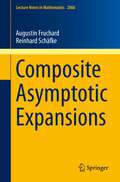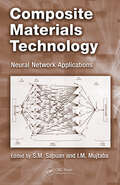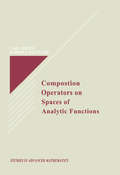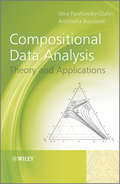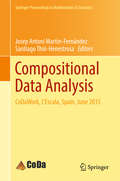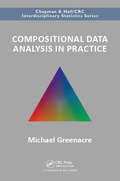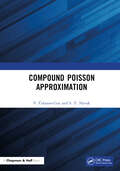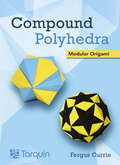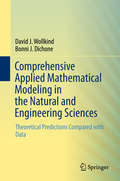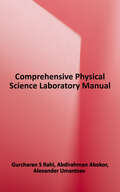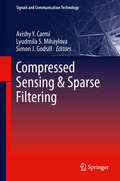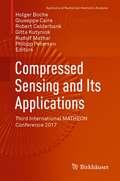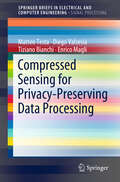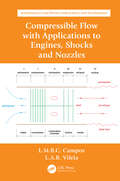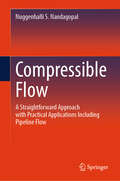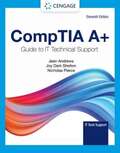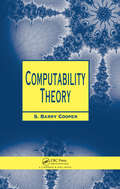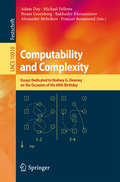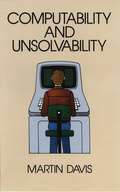- Table View
- List View
Composite Asymptotic Expansions (Lecture Notes in Mathematics #2066)
by Augustin Fruchard Reinhard SchafkeThe purpose of these lecture notes is to develop a theory of asymptotic expansions for functions involving two variables, while at the same time using functions involving one variable and functions of the quotient of these two variables. Such composite asymptotic expansions (CAsEs) are particularly well-suited to describing solutions of singularly perturbed ordinary differential equations near turning points. CAsEs imply inner and outer expansions near turning points. Thus our approach is closely related to the method of matched asymptotic expansions. CAsEs offer two unique advantages, however. First, they provide uniform expansions near a turning point and away from it. Second, a Gevrey version of CAsEs is available and detailed in the lecture notes. Three problems are presented in which CAsEs are useful. The first application concerns canard solutions near a multiple turning point. The second application concerns so-called non-smooth or angular canard solutions. Finally an Ackerberg-O'Malley resonance problem is solved.
Composite Materials Technology: Neural Network Applications
by S. M. Sapuan I. M. MujtabaArtificial neural networks (ANN) can provide new insight into the study of composite materials and can normally be combined with other artificial intelligence tools such as expert system, genetic algorithm, and fuzzy logic. Because research on this field is very new, there is only a limited amount of published literature on the subject.Compiling in
Composite Sampling: A Novel Method to Accomplish Observational Economy in Environmental Studies (Environmental and Ecological Statistics #4)
by Sharad D. Gore Ganapati P. Patil Charles TaillieSampling consists of selection, acquisition, and quantification of a part of the population. While selection and acquisition apply to physical sampling units of the population, quantification pertains only to the variable of interest, which is a particular characteristic of the sampling units. A sampling procedure is expected to provide a sample that is representative with respect to some specified criteria. Composite sampling, under idealized conditions, incurs no loss of information for estimating the population means. But an important limitation to the method has been the loss of information on individual sample values, such as, the extremely large value. In many of the situations where individual sample values are of interest or concern, composite sampling methods can be suitably modified to retrieve the information on individual sample values that may be lost due to compositing. This book presents statistical solutions to issues that arise in the context of applications of composite sampling.
Composition Operators on Spaces of Analytic Functions (Studies In Advanced Mathematics Ser. #20)
by Carl C. Cowen Jr.The study of composition operators lies at the interface of analytic function theory and operator theory. Composition Operators on Spaces of Analytic Functions synthesizes the achievements of the past 25 years and brings into focus the broad outlines of the developing theory. It provides a comprehensive introduction to the linear operators of composition with a fixed function acting on a space of analytic functions. This new book both highlights the unifying ideas behind the major theorems and contrasts the differences between results for related spaces. Nine chapters introduce the main analytic techniques needed, Carleson measure and other integral estimates, linear fractional models, and kernel function techniques, and demonstrate their application to problems of boundedness, compactness, spectra, normality, and so on, of composition operators. Intended as a graduate-level textbook, the prerequisites are minimal. Numerous exercises illustrate and extend the theory. For students and non-students alike, the exercises are an integral part of the book. By including the theory for both one and several variables, historical notes, and a comprehensive bibliography, the book leaves the reader well grounded for future research on composition operators and related areas in operator or function theory.
Compositional Data Analysis
by Vera Pawlowsky-Glahn Antonella BucciantiIt is difficult to imagine that the statistical analysis of compositional data has been a major issue of concern for more than 100 years. It is even more difficult to realize that so many statisticians and users of statistics are unaware of the particular problems affecting compositional data, as well as their solutions. The issue of ``spurious correlation'', as the situation was phrased by Karl Pearson back in 1897, affects all data that measures parts of some whole, such as percentages, proportions, ppm and ppb. Such measurements are present in all fields of science, ranging from geology, biology, environmental sciences, forensic sciences, medicine and hydrology.This book presents the history and development of compositional data analysis along with Aitchison's log-ratio approach. Compositional Data Analysis describes the state of the art both in theoretical fields as well as applications in the different fields of science.Key Features:Reflects the state-of-the-art in compositional data analysis.Gives an overview of the historical development of compositional data analysis, as well as basic concepts and procedures.Looks at advances in algebra and calculus on the simplex.Presents applications in different fields of science, including, genomics, ecology, biology, geochemistry, planetology, chemistry and economics.Explores connections to correspondence analysis and the Dirichlet distribution.Presents a summary of three available software packages for compositional data analysis.Supported by an accompanying website featuring R code.Applied scientists working on compositional data analysis in any field of science, both in academia and professionals will benefit from this book, along with graduate students in any field of science working with compositional data.
Compositional Data Analysis
by Josep Antoni Martín-Fernández Santiago Thió-HenestrosaThe authoritative contributions gathered in this volume reflect the state of the art in compositional data analysis (CoDa). The respective chapters cover all aspects of CoDa, ranging from mathematical theory, statistical methods and techniques to its broad range of applications in geochemistry, the life sciences and other disciplines. The selected and peer-reviewed papers were originally presented at the 6th International Workshop on Compositional Data Analysis, CoDaWork 2015, held in L’Escala (Girona), Spain.Compositional data is defined as vectors of positive components and constant sum, and, more generally, all those vectors representing parts of a whole which only carry relative information. Examples of compositional data can be found in many different fields such as geology, chemistry, economics, medicine, ecology and sociology. As most of the classical statistical techniques are incoherent on compositions, in the 1980s John Aitchison proposed the log-ratio approach to CoDa. This became the foundation of modern CoDa, which is now based on a specific geometric structure for the simplex, an appropriate representation of the sample space of compositional data. The International Workshops on Compositional Data Analysis offer a vital discussion forum for researchers and practitioners concerned with the statistical treatment and modelling of compositional data or other constrained data sets and the interpretation of models and their applications. The goal of the workshops is to summarize and share recent developments, and to identify important lines of future research.
Compositional Data Analysis in Practice (Chapman & Hall/CRC Interdisciplinary Statistics)
by Michael GreenacreCompositional Data Analysis in Practice is a user-oriented practical guide to the analysis of data with the property of a constant sum, for example percentages adding up to 100%. Compositional data can give misleading results if regular statistical methods are applied, and are best analysed by first transforming them to logarithms of ratios. This book explains how this transformation affects the analysis, results and interpretation of this very special type of data. All aspects of compositional data analysis are considered: visualization, modelling, dimension-reduction, clustering and variable selection, with many examples in the fields of food science, archaeology, sociology and biochemistry, and a final chapter containing a complete case study using fatty acid compositions in ecology. The applicability of these methods extends to other fields such as linguistics, geochemistry, marketing, economics and finance. <P><P>R Software <P><P>The following repository contains data files and R scripts from the book https://github.com/michaelgreenacre/CODAinPractice . The R package easyCODA, which accompanies this book, is available on CRAN -- note that you should have version 0.25 or higher. The latest version of the package will always be available on R-Forge and can be installed from R with this instruction: install.packages("easyCODA", repos="http://R-Forge.R-project.org").
Compound Poisson Approximation
by V. Čekanavičius S. Y. NovakCompound Poisson approximation appears naturally in situations where one deals with a large number of rare events. It has important applications in insurance, extreme value theory, reliability theory, mathematical biology, and more. Compound Poisson Approximation synthesizes the most important recent research in the field in a single volume. With an extensive list of references, open problems, and exercises, it will become the standard reference book on the topic. Features• Provides a comprehensive overview of this rapidly expanding field • Synthesizes the most important research results of recent years • Presents an array of special topics• Provides the reader with a set of tools needed for research and education The book is of interest to researchers and postgraduate students from probability, statistics, and mathematics.
Compound Polyhedra: Modular Origami
by Fergus CurrieA book of ten geometric models of advanced modular origami designed by Fergus Currie with full instructions and diagrams on how to make the following: 1.The Compound of Two Cubes2.The Compound of Two Tetrahedra3.The Compound of the Octahedron and the Cube4.The Compound of Three Cubes5.The Compound of Five Octahedra6.The Compound of Three Octahedra7.The Compound of Three Tetrahedra8.The Compound of the Icosahedron and the Dodecahedron9.The Small Triambic Icosahedron (STI)10.and11.The Compound of the STI and the Dodecahedron.It also includes an introduction with sections on the mathematics behind the models; a short history of modular origami; a section on tools and folding techniques, and a gallery of the finished models that are presented in the book.
Comprehensive Applied Mathematical Modeling in the Natural and Engineering Sciences: Theoretical Predictions Compared With Data
by David J. Wollkind Bonni J. DichoneThis text demonstrates the process of comprehensive applied mathematical modeling through the introduction of various case studies. The case studies are arranged in increasing order of complexity based on the mathematical methods required to analyze the models. The development of these methods is also included, providing a self-contained presentation. To reinforce and supplement the material introduced, original problem sets are offered involving case studies closely related to the ones presented. With this style, the text’s perspective, scope, and completeness of the subject matter are considered unique. Having grown out of four self-contained courses taught by the authors, this text will be of use in a two-semester sequence for advanced undergraduate and beginning graduate students, requiring rudimentary knowledge of advanced calculus and differential equations, along with a basic understanding of some simple physical and biological scientific principles.
Comprehensive Mathematics (ORIGO Stepping Stones 2.0 #Student Book B)
by James Burnett Calvin Irons Peter StowasserComprehensive Mathematics (ORIGO Stepping Stones 2.0, #Student Book A)
by James Burnett Calvin Irons Peter StowasserComprehensive Physical Science Laboratory Manual
by Alexander Umantsev Gurcharan S Rahi Abdirahman AbokorThis is a laboratory manual for a one-semester college physical science course. This manual aims to familiarize students with some of the fundamental concepts of physical science by providing the opportunity to experimentally test the theories and hypotheses of physics and chemistry discussed in the lectures. Conducting experiments and collecting data to test the validity of theories and laws requires a different set of skills than those required for success in lecture. The work done in the laboratory will augment the student’s understanding of the lecture material as well as provide them with the opportunity to become familiar with the basic experimental techniques. Laboratory sessions described by the guide are designed to provide a hands-on introduction to experimental methods of scientific investigation. Each one provides the practical knowledge necessary for a well-rounded understanding of physical science.
Compressed Sensing
by Yonina C. Eldar Gitta KutyniokCompressed sensing is an exciting, rapidly growing field, attracting considerable attention in electrical engineering, applied mathematics, statistics and computer science. This book provides the first detailed introduction to the subject, highlighting recent theoretical advances and a range of applications, as well as outlining numerous remaining research challenges. After a thorough review of the basic theory, many cutting-edge techniques are presented, including advanced signal modeling, sub-Nyquist sampling of analog signals, non-asymptotic analysis of random matrices, adaptive sensing, greedy algorithms and use of graphical models. All chapters are written by leading researchers in the field, and consistent style and notation are utilized throughout. Key background information and clear definitions make this an ideal resource for researchers, graduate students and practitioners wanting to join this exciting research area. It can also serve as a supplementary textbook for courses on computer vision, coding theory, signal processing, image processing and algorithms for efficient data processing.
Compressed Sensing & Sparse Filtering (Signals and Communication Technology)
by Avishy Y. Carmi Lyudmila S. Mihaylova Simon J. GodsillThis book is aimed at presenting concepts, methods and algorithms ableto cope with undersampled and limited data. One such trend that recently gained popularity and to some extent revolutionised signal processing is compressed sensing. Compressed sensing builds upon the observation that many signals in nature are nearly sparse (or compressible, as they are normally referred to) in some domain, and consequently they can be reconstructed to within high accuracy from far fewer observations than traditionally held to be necessary. Apart from compressed sensing this book contains other related approaches. Each methodology has its own formalities for dealing with such problems. As an example, in the Bayesian approach, sparseness promoting priors such as Laplace and Cauchy are normally used for penalising improbable model variables, thus promoting low complexity solutions. Compressed sensing techniques and homotopy-type solutions, such as the LASSO, utilise l1-norm penalties for obtaining sparse solutions using fewer observations than conventionally needed. The book emphasizes on the role of sparsity as a machinery for promoting low complexity representations and likewise its connections to variable selection and dimensionality reduction in various engineering problems. This book is intended for researchers, academics and practitioners with interest in various aspects and applications of sparse signal processing.
Compressed Sensing and Its Applications: Third International MATHEON Conference 2017 (Applied and Numerical Harmonic Analysis)
by Gitta Kutyniok Holger Boche Robert Calderbank Giuseppe Caire Rudolf Mathar Philipp PetersenThe chapters in this volume highlight the state-of-the-art of compressed sensing and are based on talks given at the third international MATHEON conference on the same topic, held from December 4-8, 2017 at the Technical University in Berlin. In addition to methods in compressed sensing, chapters provide insights into cutting edge applications of deep learning in data science, highlighting the overlapping ideas and methods that connect the fields of compressed sensing and deep learning. Specific topics covered include:Quantized compressed sensingClassificationMachine learningOracle inequalitiesNon-convex optimizationImage reconstructionStatistical learning theoryThis volume will be a valuable resource for graduate students and researchers in the areas of mathematics, computer science, and engineering, as well as other applied scientists exploring potential applications of compressed sensing.
Compressed Sensing for Privacy-Preserving Data Processing (SpringerBriefs in Electrical and Computer Engineering)
by Enrico Magli Matteo Testa Diego Valsesia Tiziano BianchiThe objective of this book is to provide the reader with a comprehensive survey of the topic compressed sensing in information retrieval and signal detection with privacy preserving functionality without compromising the performance of the embedding in terms of accuracy or computational efficiency. The reader is guided in exploring the topic by first establishing a shared knowledge about compressed sensing and how it is used nowadays. Then, clear models and definitions for its use as a cryptosystem and a privacy-preserving embedding are laid down, before tackling state-of-the-art results for both applications. The reader will conclude the book having learned that the current results in terms of security of compressed techniques allow it to be a very promising solution to many practical problems of interest. The book caters to a broad audience among researchers, scientists, or engineers with very diverse backgrounds, having interests in security, cryptography and privacy in information retrieval systems. Accompanying software is made available on the authors’ website to reproduce the experiments and techniques presented in the book. The only background required to the reader is a good knowledge of linear algebra, probability and information theory.
Compressible Flow with Applications to Engines, Shocks and Nozzles (Mathematics and Physics for Science and Technology #11)
by Luis Manuel Braga da Costa Campos Luís António Raio VilelaCompressible Flow with Application to Shocks and Propulsion is part of the series "Mathematics and Physics for Science and Technology", which combines rigorous mathematics with general physical principles to model practical engineering systems with a detailed derivation and interpretation of results. Volume V presents the mathematical theory of partial differential equations and methods of solution satisfying initial and boundary conditions, and includes applications to: acoustic, elastic, water, electromagnetic and other waves; the diffusion of heat, mass and electricity; and their interactions. This is the second book of the volume. The first book of volume V starts with the classification of partial differential equations and proceeds with similarity methods that apply in general to linear equations with constant coefficients and all derivatives of the same order, such as the Laplace and Biharmonic equations, without and with forcing. The similarity solutions are also applied to Burger's non-linear diffusion equation. First-order linear and quasi-linear partial differential equations with variable coefficients are considered, with application to the representation of conservative/non-conservative, solenoidal/rotational and Beltrami/helical vector fields by one, two or three scalar and/or one vector potential in relation with exact, inexact and non-integrable differentials. The latter appear in the first and second principles of thermodynamics that specify the constitutive and diffusive properties of matter as concerns thermal, mechanical, elastic, flow, electrical, magnetic and chemical phenomena and their interactions. The book is intended for graduate students and engineers working with mathematical models and can be applied to problems in mechanical, aerospace, electrical and other branches of engineering dealing with advanced technology, and also in the physical sciences and applied mathematics. This book: Simultaneously covers rigorous mathematics, general physical principles and engineering applications with practical interest Provides interpretation of results with the help of illustrations Includes detailed proofs of all results L.M.B.C. Campos was chair professor and the Coordinator of the Scientific Area of Applied and Aerospace Mechanics in the Department of Mechanical Engineering and also the director (and founder) of the Center for Aeronautical and Space Science and Technology until retirement in 2020. L.A.R. Vilela is currently completing an Integrated Master's degree in Aerospace Engineering at Institute Superior Tecnico (1ST) of Lisbon University.
Compressible Flow: A Straightforward Approach with Practical Applications Including Pipeline Flow
by Nuggenhalli S. NandagopalThis book focuses on the foundations of compressible flow, illustrating the use of principles of thermodynamics and fluid dynamics in the development of compressible flow equations. It presents the topics in an organized manner facilitating natural, logical flow of the subject matter. All the relevant equations are derived rigorously using basic mathematics and mass, momentum, and energy conservation principles; that is, continuity, momentum and energy equations. The applications of compressible flow equations are illustrated using numerous example and practice problems. The topics covered include Mach number, isentropic flow, stagnation-static relationships, compressible flow tables for air, compressible flow measurements, Pitot Tube, Pitot Static Tube, Rayleigh-Pitot Equation, compressible flow with area changes, sonic flow, sonic area, sonic relationships, shock waves, shock wave relationships, normal shock waves in nozzles, moving shock waves with applications to sudden opening and closing of valves, oblique shock waves and Prandtl-Meyer expansion waves, compressible flow through ducts and pipes, adiabatic compressible flow with friction loss, Fanno Flow, compressible flow with heat transfer, Rayleigh Flow, and isothermal compressible flow through pipelines. A unique feature of this book is that it presents novel methods to solve compressible flow problems through extensive use of spreadsheets. The spreadsheet-based solution methods presented in this book eliminates the need for cumbersome trial and error procedures and they can be used in solving a great variety of problems just by suitably changing the required inputs. This book also presents a ground-breaking, rigorous approach to solving gas flow problems in pipelines through the use of appropriate generalized compressibility factors and friction factors, dispelling the wide range of results that one can possibly obtain from approaches such as Weymouth and Panhandle equations. Includes 85+ Illustrative example problems and 40+ practice problems, both with detailed solutions (in both S I and US Customary units) Presents rigorous derivations of all relevant equations using fundamental mathematics and relevant physical principles Explains concepts in an accessible and thorough manner with practical applications that readers can easily understand Extensive use of spreadsheets in solving compressible flow problems
Compressive Sensing for Wireless Networks
by Wotao Yin Zhu Han Husheng LiCompressive sensing is a new signal processing paradigm that aims to encode sparse signals by using far lower sampling rates than those in the traditional Nyquist approach. It helps acquire, store, fuse and process large data sets efficiently and accurately. This method, which links data acquisition, compression, dimensionality reduction and optimization, has attracted significant attention from researchers and engineers in various areas. This comprehensive reference develops a unified view on how to incorporate efficiently the idea of compressive sensing over assorted wireless network scenarios, interweaving concepts from signal processing, optimization, information theory, communications and networking to address the issues in question from an engineering perspective. It enables students, researchers and communications engineers to develop a working knowledge of compressive sensing, including background on the basics of compressive sensing theory, an understanding of its benefits and limitations, and the skills needed to take advantage of compressive sensing in wireless networks.
Comptia A+ Guide To Information Technology Technical Support
by Jean Andrews Joy Shelton Nicholas PierceUsing a step-by-step, highly visual approach, Andrews/Dark Shelton/Pierce's bestselling COMPTIA A+ GUIDE TO IT TECHNICAL SUPPORT, 11th edition, teaches you how to work with users as well as install, maintain, troubleshoot and network computer hardware and software. Ensuring you are well prepared for 220-1101 and 220-1102 certification exams, each module covers core and advanced topics while emphasizing practical application of the most current technology, techniques and industry standards. You will study the latest hardware, security, Active Directory, operational procedures, basics of scripting, virtualization, cloud computing, mobile devices, Windows 10, macOS and Linux. Digital lab manuals, live virtual machine labs, simulations, auto-graded quizzes and interactive activities provide additional preparation for the certification exam -- and your role as an IT support technician or administrator.
Computability Theory: Journeys Beyond The Turing Barrier (Chapman Hall/CRC Mathematics Series)
by S. Barry Cooper<p>Computability theory originated with the seminal work of Gödel, Church, Turing, Kleene and Post in the 1930s. This theory includes a wide spectrum of topics, such as the theory of reducibilities and their degree structures, computably enumerable sets and their automorphisms, and subrecursive hierarchy classifications. Recent work in computability theory has focused on Turing definability and promises to have far-reaching mathematical, scientific, and philosophical consequences. <p>Written by a leading researcher, Computability Theory provides a concise, comprehensive, and authoritative introduction to contemporary computability theory, techniques, and results. The basic concepts and techniques of computability theory are placed in their historical, philosophical and logical context. This presentation is characterized by an unusual breadth of coverage and the inclusion of advanced topics not to be found elsewhere in the literature at this level.The book includes both the standard material for a first course in computability and more advanced looks at degree structures, forcing, priority methods, and determinacy. The final chapter explores a variety of computability applications to mathematics and science. <p>Computability Theory is an invaluable text, reference, and guide to the direction of current research in the field. Nowhere else will you find the techniques and results of this beautiful and basic subject brought alive in such an approachable and lively way.</p>
Computability and Complexity: Essays Dedicated to Rodney G. Downey on the Occasion of His 60th Birthday (Lecture Notes in Computer Science #10010)
by Adam Day, Michael Fellows, Noam Greenberg, Bakhadyr Khoussainov, Alexander Melnikov and Frances RosamondThis Festschrift is published in honor of Rodney G. Downey, eminent logician and computer scientist, surfer and Scottish country dancer, on the occasion of his 60th birthday.The Festschrift contains papers and laudations that showcase the broad and important scientific, leadership and mentoring contributions made by Rod during his distinguished career. The volume contains 42 papers presenting original unpublished research, or expository and survey results in Turing degrees, computably enumerable sets, computable algebra, computable model theory, algorithmic randomness, reverse mathematics, and parameterized complexity, all areas in which Rod Downey has had significant interests and influence. The volume contains several surveys that make the various areas accessible to non-specialists while also including some proofs that illustrate the flavor of the fields.
Computability and Logic
by John P. Burgess George S. Boolos Richard C. JeffreyThis fourth edition of one of the classic logic textbooks has been thoroughly revised by John Burgess. The aim is to increase the pedagogical value of the book for the core market of students of philosophy and for students of mathematics and computer science as well. This book has become a classic because of its accessibility to students without a mathematical background, and because it covers not simply the staple topics of an intermediate logic course such as Godel's Incompleteness Theorems, but also a large number of optional topics from Turing's theory of computability to Ramsey's theorem. John Burgess has now enhanced the book by adding a selection of problems at the end of each chapter, and by reorganising and rewriting chapters to make them more independent of each other and thus to increase the range of options available to instructors as to what to cover and what to defer.<P> Advisory: Bookshare has learned that this book offers only partial accessibility. We have kept it in the collection because it is useful for some of our members. To explore further access options with us, please contact us through the Book Quality link on the right sidebar. Benetech is actively working on projects to improve accessibility issues such as these.
Computability and Unsolvability
by Prof. Martin DavisIn this classic text, Dr. Davis provides a clear introduction to computability, at an advanced undergraduate level, that serves the needs of specialists and non-specialists alike.In Part One (Chapters 1–5), Professor Davis outlines the general theory of computability, discussing such topics as computable functions, operations on computable functions, recursive functions, Turing machines, self-applied, and unsolvable decision problems. The author has been careful, especially in the first seven chapters, to assume no special mathematical training on the part of the reader.Part Two (Chapters 6–8) comprises a concise treatment of applications of the general theory, incorporating material on combinatorial problems, Diophantine Equations (including Hilbert's Tenth Problem) and mathematical logic. The final three chapters (Part 3) present further development of the general theory, encompassing the Kleene hierarchy, computable functionals, and the classification of unsolvable decision problems.When first published in 1958, this work introduced much terminology that has since become standard in theoretical computer science. Indeed, the stature of the book is such that many computer scientists regard it as their theoretical introduction to the topic. This new Dover edition makes this pioneering, widely admired text available in an inexpensive format.For Dover's edition, Dr. Davis has provided a new Preface and an Appendix, "Hilbert's Tenth Problem Is Unsolvable," an important article he published in The American Mathematical Monthly in 1973, which was awarded prizes by the American Mathematical Society and the Mathematical Association of America. These additions further enhance the value and usefulness of an "unusually clear and stimulating exposition" (Centre National de la Recherche Scientifique, Paris) now available for the first time in paperback.
